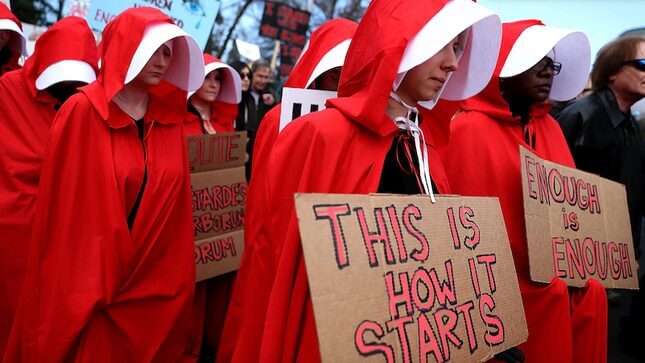
Image: Getty
“Margaret Atwood’s new novel is being greeted as the long-awaited feminist dystopia, and I am afraid that for some time it will be viewed as a test of the imaginative power of feminist paranoia,” the writer and critic Barbara Ehrenreich wrote in 1986, soon after the publication of Margaret Atwood’s novel The Handmaid’s Tale.
To Ehrenreich, The Handmaid’s Tale was “a thoroughly feminist nightmare,” though not perhaps in the ways that it’s popularly considered today. “We are warned,” she wrote, “not only about the theocratic ambitions of the religious right, but about a repressive tendency in feminism itself. Only on the surface is Gilead a fortress of patriarchy, Old Testament style. It is also, in a thoroughly sinister and distorted way, the utopia of cultural feminism.” This is what made The Handmaid’s Tale, in her mind, a “fantasy of regression that is almost as seductive, in a perverse way, as it is repellent.”
I have found myself thinking of that seductive appeal in recent weeks, in light of the breathless excitement generated by The Testaments, Atwood’s just-released sequel to The Handmaid’s Tale that takes place 15 years after the first novel ends. Today, The Handmaid’s Tale is more often described as “chillingly prophetic,” ostensibly made all the more prescient after the election of Donald Trump; it didn’t help matters that Hulu’s popular adaptation of Atwood’s novel, which was planned when everyone thought Hillary Clinton would breeze to victory, instead landed during a presidency where women’s bodily autonomy has been under increasing attack. “We Live in the Reproductive Dystopia of ‘The Handmaid’s Tale,’” proclaimed a headline in the New Yorker. “Few writers have been so close to the pulse of this past tumultuous year than Margaret Atwood,” wrote Slate in 2017, adding, “The worlds Atwood describes are uncomfortably close to our own, and they seem to be drawing closer.” Yet somehow, despite the brutality of the world depicted by The Handmaid’s Tale, we can’t seem to get enough: According to Amazon, The Handmaid’s Tale was the most-read novel of 2017, and the audience for Hulu’s adaptation, which will have a fourth season, is only growing.
The Handmaid’s Tale jumped from the page and screen into the real world as the costume of the handmaid became a symbol of women’s political protest. In March of 2017, (overwhelmingly white) women in Texas donned red robes and white bonnets to protest yet another anti-abortion bill being taken up by the state legislature, where they sat in the balcony, mute. That action inspired a group of women in Missouri, six weeks later, to don their own costumes, and a political meme was born. (Few perhaps now remember that it was Hulu, in a neat marketing trick, who first dressed up women in handmaid costumes and had them stroll the streets of Austin, in advance of the premiere of the television show.) “The easiest way we try to explain it is that the handmaids represent a future where women are nothing more than their reproductive capacity,” explained Heather Busby, the executive director of NARAL Pro-Choice Texas, who was inspired after seeing Hulu’s stunt to then deploy the costume as a protest. “Unfortunately, with the laws that are being passed, that future is not so unrealistic and not so distant.”
But if the handmaid protesters have couched their protest as a warning, it seems to me that part of the appeal of The Handmaid’s Tale—and the odd, sticky allure of imagining oneself as a handmaid—comes not from its dystopian powers of prophecy, but from how, as the feminist critic Sophie Lewis has written, echoing Ehrenreich, it “functions as a kind of utopia,” one where the pesky differences that divide feminists today are not just flattened but simply do not exist, and where everything can be blamed on religious fundamentalists with guns. In this fucked-up utopia, Lewis writes, “feminist solidarity would automatically flourish in the worst of all possible worlds” and “the vast majority of women [are] finally seeing the light and counting themselves as feminists because society has started systematically treating them all—not just black women—like chattel.”
-

-

-

-

-

-

-

-

-

-

-

-

-

-

-

-

-

-

-

-

-

-

-

-

-

-

-

-

-

-

-

-

-

-

-

-

-

-

-

-








































